#iot data plans
Explore tagged Tumblr posts
Text

Transforming urban living with IoT technologies! 🏙💡 Discover how smart cities are becoming more secure, sustainable, and connected through innovative solutions. From energy-efficient systems to intelligent infrastructure, IoT is reshaping the future of urbanization. 🌍🚀
#Smart city IoT#IoT in urban planning#Cybersecurity in smart cities#IoT and energy management#Internet of Things (IoT)#Blockchain in smart cities#Real-time data in cities#AI in urban transportation
0 notes
Text
In today’s fast-paced world of logistics innovation and evolution have become the driving forces behind success. As we step into 2024, the logistics sector will undergo extensive disruptions, fueled by game-changing innovations that promise to revolutionize supply chain management as we know it.
At iFour, we take immense pride in our expertise in the logistics industry, and we are excited to share with you the trends that are currently transforming this dynamic sector in Australia. As a leading custom Logistics software development company, we understand the unique challenges and opportunities facing businesses in the Australian market.
Here are the key trends that are reshaping the logistics landscape and how our solutions can help your company stay ahead of the curve.
#Supply Chain Technology#E-commerce Logistics#Automation and Robotics#Blockchain in Logistics#Sustainable and Green Logistics#Last-Mile Delivery Solutions#Data Analytics and Predictive Insights#3D Printing in Logistics#IoT (Internet of Things) in Supply Chain#Artificial Intelligence in Transportation#On-Demand and Sharing Economy Logistics#Digital Twins in Warehousing#Autonomous Vehicles and Drones#Climate Change and Resilience Planning#Cross-Border Trade and Customs#Cybersecurity in Supply Chain#Inventory Management Strategies#Reverse Logistics and Returns#Multi-Modal Transportation#software outsourcing#software development company#.net development
0 notes
Text
Challenge: The Future of Resilience - Technology Org
New Post has been published on https://thedigitalinsider.com/challenge-the-future-of-resilience-technology-org/
Challenge: The Future of Resilience - Technology Org


The future of resilient cities prioritizes preparedness, proactive planning, and the implementation of innovative strategies to build and maintain strong foundations that can withstand and recover quickly from disruptions.
By establishing efficient waste management systems, preserving natural habitats, and encouraging predictive maintenance options, resilient cities can improve the overall quality of life for residents by adopting cloud-connected sensor technologies to drive useful insight to help identify potential risks, develop emergency response plans, and implement early warning systems.
In this contest, the Seeker is asking participants to use Microchip’s AVR-IoT Cellular Mini to develop and demonstrate a comprehensive system that reads sensor data and then creates an action.
Submissions to this Challenge must be received by 12:00 PM PST, February 29, 2024.
Source: Hackster.io
You can offer your link to a page which is relevant to the topic of this post.
#2024#challenge#cities#Cloud#Competitions#comprehensive#data#Featured technology news#Future#Innovation#InSight#IoT#life#Link#management#natural#Planning#pm#recover#resilience#risks#sensor#Smart Cities#Software news#technology#waste#waste management#waste managment
0 notes
Text
IoT Adoption and Security Issues in French Cities
The Internet of Things (IoT) is rapidly changing the way we interact with technology, and French cities are no exception. As urban centers seek to become more efficient and sustainable, they are increasingly turning to IoT devices to help manage everything from traffic flow to energy usage. However, as with any new technology, there are also significant security challenges that must be addressed…

View On WordPress
#Citizen engagement#CYBERSECURITY#Data management#Data privacy#Digital transformation#Energy efficiency#French cities#Internet connectivity#IoT#Mobile devices#Network security#Public services#Risk management#Security challenges#Sensor technology#Smart cities#Sustainability#Urban infrastructure#Urban planning
0 notes
Text
EU ‘Going Dark’ Expert Group Publishes 42-Point Surveillance Plan For Access To All Devices And Data At All Times
Although this “chat control” law has been the main focus of the EU’s push for more surveillance of innocent citizens, it is by no means the end of it. As the German digital rights site Netzpolitik reports, work is already underway on further measures, this time to address the non-existent “going dark” threat to law enforcement:
The group of high-level experts had been meeting since last year to tackle the so-called „going dark“ problem. The High-Level Group set up by the EU was characterized by a bias right from the start: The committee is primarily made up of representatives of security authorities and therefore represents their perspective on the issue.
[T]he 42-point surveillance plan, manufacturers are to be legally obliged to make digital devices such as smartphones, smart homes, IoT devices, and cars monitorable at all times (“access by design”). Messenger services that were previously securely encrypted are to be forced to allow for interception. Data retention, which was overturned by the EU Court of Justice, is to be reenacted and extended to OTT internet communications services such as messenger services. “At the very least”, IP connection data retention is to be required to be able to track all internet activities. The secure encryption of metadata and subscriber data is to be prohibited. Where requested by the police, GPS location tracking should be activated by service providers (“tracking switch”). Uncooperative providers are to be threatened with prison sentences. The results of the hacking of an entire communication service, as in the Encrochat case (the evidence has been rejected by some courts), shall be used as evidence in court. — Patrick Breyer, June 2024
#fascism#surveillance#police state#european union#eu#big brother#chat control#free speech#free association#internet#2024#government spying#social control#data mining
6 notes
·
View notes
Text

The report on the approximate air support competition between the A-10 and the F-35 appears
Fernando Valduga By Fernando Valduga 03/11/2023 - 22:35in Military
A newly emerged report offers some new details about a test that compared the A-10 Warthog attack plane and the F-35 Joint Strike Fighter attack fighter, but raises more questions about the ability of the 5ª generation jet to complete the A-10's approximate air support mission.
The confidential report, completed in February 2022 by the Department of Defense's Testing and Evaluation Office, was recently released with heavy writings to the Government Supervision Project, which sued the Pentagon in a federal court after its FOIA request for the report was denied.

The report describes the results of an approximate air support flight between the F-35A and the A-10C, which was determined by Congress in the National Defense Authorization Act of 2017 and carried out in 2019.
The test was conducted in “low and medium threat environments” and not in a hostile or high threat environment because the “F-35A, along with the F-35B and F-35C, is being thoroughly evaluated during the IOT&E of the F-35 in high threat scenarios versus modern and dense combat aircraft and surface-to-air missiles, missions for which the A-10C was not designed,” the report said.

No ground troops participated in the flight, which does not “invalidate the conclusions of this report,” DOT&E wrote in the report. "However, a more dynamic and representative environment may be required for operational testing of these missions to evaluate improvements in the performance of these or any other systems under test."
Many details are hidden in the version released for POGO. For example, it says that the A-10 “allowed more attacks than the typical loading of the F-35A,” but does not reveal how many targets each aircraft hit in the test.
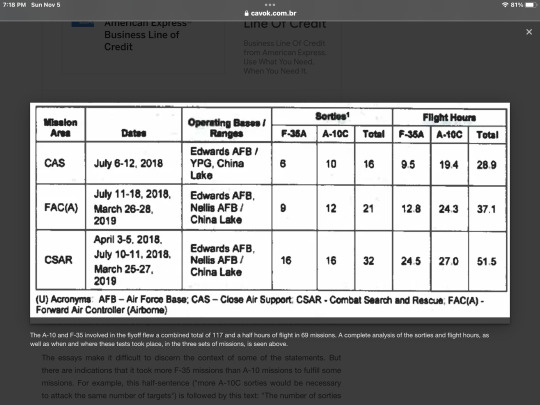
The A-10 and F-35 involved in the flyoff flew a combined total of 117 and a half hours of flight in 69 missions. A complete analysis of the sorties and flight hours, as well as when and where these tests took place, in the three sets of missions, is seen above.
The essays make it difficult to discern the context of some of the statements. But there are indications that it took more F-35 missions than A-10 missions to fulfill some missions. For example, this half-sentence ("more A-10C sorties would be necessary to attack the same number of targets") is followed by this text: "The number of sorties needed to complete the same mission objectives in contested environments would depend on air defense suppression plans."

This may result in part of the A-10's ability to carry more ammunition. The attack plane was designed around a huge 30mm GAU-8 cannon that contains 1,350 cartridges of ammunition, while the F-35's 25mm GAU-22 cannon can carry only about 181 cartridges.
Elsewhere, the report noted the ability of the A-10 to fly closer to the targets than the F-35:
youtube
"The test team did not record the inclined range of the target with the generated coordinates, so its effect cannot be evaluated directly. Even so, tactics usually caused A-10C pilots to fly closer to the target than F-35A pilots, which could explain some of the differences in measured location errors. The target location error only affects the use of GPS-aided weapons. In any case, the location error is sufficient to indicate the aiming pod of another aircraft [approximate air support].

A table listing various competitive capabilities between the F-35A and A-10C at the time of flyoff. DOD via FOIA/POGO
The report also noted that the most recent weapon did not always manage to fire in a straight line. DOT&E told the Pentagon to “fix the F-35A cannon, improve digital communication, video data linkability and interoperability with 4ª generation aircraft, and develop training programs to further improve the effectiveness of the F-35A in these missions.”

Russ Goemaere, spokesman for the F-35 Joint Program Office, said that the program "improved" the weapon and interoperability of the jet with 4ª generation fighters and said that "they are effective".
In his own analysis, Dan Grazier of POGO wrote: "Despite the heavy essays in the released report, it is clear that the results of these flawed tests disappointed the constituted powers. If the F-35 had been the winner, there would be no doubt that a clear and declarative statement of this fact would have appeared prominently in the initial paragraph of the report."

The U.S. Air Force did not want to comment on the report, nor did it say whether the leaders of the armed forces tried to prevent the release of the report. A spokesman said that close air support is a mission, not a specific platform.
"The future force will inherently be capable of approximate air support, with multifunctional capabilities to ensure survivability in all scenarios. Although successful in permissive environments, the A-10 will not have the ability to survive in a highly disputed future fight,” said service spokeswoman Ann Stefanek.

The U.S. military has made intense use of the A-10 in recent decades, moving it to Iraq for multiple conflicts and to Afghanistan against the Taliban. More recently, the U.S. sent Warthogs to the Middle East to deter aggression and prevent the spread of the Israel-Hamas war.
Air Force officers have sought to retire the A-10, which was introduced in 1977 as a Soviet tanker. But their arguments - that money would be better applied to more modern aircraft, that satellite and laser-guided bombs were sufficient for close air support missions - met strong resistance from legislators whose districts housed A-10 or ground troops they protect. Still, the last few years seem to be ending the service of the plane.

An A-10 Warthog, in the lower left corner, flies along with, at the top, from left to right, an F-16C Viper, an F-35A Joint Strike Fighter and an F-15E Strike Eagle. (photo: USAF)
When asked about the report, one of the prominent members of the House Armed Services Committee said he is ready to say goodbye to the A-10 - if not its capabilities. Congressman, chairman of the tactical subcommittee on air and ground forces of the HASC, says he is confident that the Air Force will be able to find a way to maintain approximate air support capabilities as it advances to the F-35.
Source: Defense One
Tags: A-10 Thunderbolt IIMilitary AviationCAS - Close-Air SupportLockheed Martin F-35A Lightning IIUSAF - United States Air Force / U.S. Air Force
Sharing
tweet
Fernando Valduga
Fernando Valduga
Aviation photographer and pilot since 1992, has participated in several events and air operations, such as Cruzex, AirVenture, Dayton Airshow and FIDAE. He has work published in specialized aviation magazines in Brazil and abroad. Uses Canon equipment during his photographic work in the world of aviation.
Related news
BRAZIL
FAB: VC-2 aircraft repatriates Brazilians who were in the West Bank
03/11/2023 - 19:33
MILITARY
New image of the B-21 Raider shows mysterious vertical elements on the tail
03/11/2023 - 18:51
MILITARY
L3Harris will modernize the electronic warfare system of the U.S. Navy F/A-18
03/11/2023 - 16:00
MILITARY
Czech Republic will establish training and simulation center for F-35 hunting
03/11/2023 - 14:00
MILITARY
Still dependent on Russia, India exchanges its MiG-21 for the Su-30 MKI
03/11/2023 - 12:30
MILITARY
Sweden orders AIM-120C-8 AMRAAM missiles for Gripen fighters
03/11/2023 - 11:00
Client PortalClient PortalClient PortalClient PortalClient PortalClient PortalClient PortalClient PortalhomeMain PageEditorialsINFORMATIONeventsCooperateSpecialitiesadvertiseabout
Cavok Brazil - Digital Tchê Web Creation
Commercial
Executive
Helicopters
HISTORY
Military
Brazilian Air Force
Space
Specialities
Cavok Brazil - Digital Tchê Web Creation
24 notes
·
View notes
Text
How to Choose the Best ERP for Engineering and Manufacturing Industry
In today’s fast-paced world, engineering and manufacturing companies face increasing pressure to deliver high-quality products while maintaining efficiency and cost-effectiveness. Implementing the right Enterprise Resource Planning (ERP) software can significantly enhance operations, streamline workflows, and boost productivity. However, with numerous options available, selecting the best ERP software for the engineering and manufacturing industry can be challenging. This guide will help you navigate this decision-making process and choose the most suitable solution for your business.
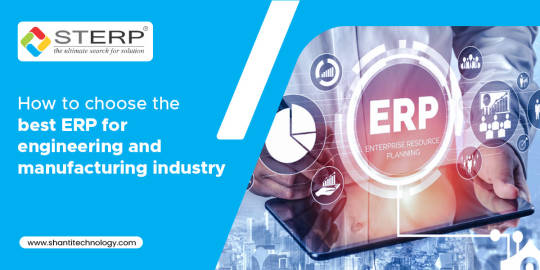
Why ERP is Crucial for Engineering and Manufacturing
ERP software integrates various business processes, including production, inventory management, supply chain, finance, and human resources. For engineering and manufacturing companies, ERP solutions are particularly vital because they:
Facilitate real-time data sharing across departments.
Enhance supply chain management.
Optimize production planning and scheduling.
Ensure compliance with industry standards.
Reduce operational costs.
Partnering with the right Engineering ERP software company ensures that your organization leverages these benefits to stay competitive in a dynamic market.
Steps to Choose the Best ERP for Engineering and Manufacturing
1. Understand Your Business Needs
Before exploring ERP solutions, evaluate your company’s specific requirements. Identify the pain points in your current processes and prioritize the features you need in an ERP system. Common features for engineering and manufacturing companies include:
Bill of Materials (BOM) management
Production planning and scheduling
Inventory control
Quality management
Financial reporting
Consulting with a reputed ERP software company can help you match your needs with the right features.
2. Look for Industry-Specific Solutions
Generic ERP software might not address the unique needs of the engineering and manufacturing sector. Opt for an ERP software in India that offers modules tailored to your industry. Such solutions are designed to handle specific challenges like multi-level BOM, project costing, and shop floor management.
3. Check Vendor Expertise
Choosing a reliable vendor is as important as selecting the software itself. Research ERP solution providers with a strong track record in serving engineering and manufacturing companies. Look for reviews, case studies, and client testimonials to gauge their expertise.
4. Evaluate Scalability and Flexibility
Your business will grow, and so will your operational requirements. Ensure that the ERP system you choose is scalable and flexible enough to accommodate future needs. The top 10 ERP software providers in India offer scalable solutions that can adapt to changing business demands.
5. Assess Integration Capabilities
An ERP system must integrate seamlessly with your existing tools, such as Computer-Aided Design (CAD) software, Customer Relationship Management (CRM) systems, and IoT devices. A well-integrated system reduces redundancies and enhances efficiency.
6. Prioritize User-Friendliness
A complex system with a steep learning curve can hinder adoption. Choose an ERP software with an intuitive interface and easy navigation. This ensures that your employees can use the system effectively without extensive training.
7. Consider Customization Options
No two businesses are alike. While standard ERP solutions offer core functionalities, some companies require customization to align with specific workflows. A trusted ERP software company in India can provide custom modules tailored to your unique needs.
8. Focus on Data Security
Engineering and manufacturing companies often deal with sensitive data. Ensure that the ERP solution complies with the latest security standards and offers robust data protection features.
9. Compare Pricing and ROI
While cost is an important factor, it should not be the sole criterion. Evaluate the long-term return on investment (ROI) offered by different ERP software. A slightly expensive but feature-rich solution from the best ERP software provider in India may deliver better value than a cheaper alternative with limited functionalities.
10. Test Before You Commit
Most ERP software companies offer free trials or demo versions. Use these opportunities to test the software in a real-world scenario. Gather feedback from your team and ensure the solution meets your expectations before finalizing your decision.
Benefits of Partnering with the Best ERP Software Providers in India
India is home to some of the leading ERP software providers in India, offering state-of-the-art solutions for the engineering and manufacturing sector. Partnering with a reputable provider ensures:
Access to advanced features tailored to your industry.
Reliable customer support.
Comprehensive training and implementation services.
Regular updates and enhancements to the software.
Companies like Shantitechnology (STERP) specialize in delivering cutting-edge ERP solutions that cater specifically to engineering and manufacturing businesses. With years of expertise, they rank among the top 10 ERP software providers in India, ensuring seamless integration and exceptional performance.
Conclusion
Selecting the right ERP software is a critical decision that can impact your company’s efficiency, productivity, and profitability. By understanding your requirements, researching vendors, and prioritizing features like scalability, integration, and security, you can find the perfect ERP solution for your engineering or manufacturing business.
If you are looking for a trusted ERP software company in India, consider partnering with a provider like STERP. As one of the best ERP software providers in India, STERP offers comprehensive solutions tailored to the unique needs of engineering and manufacturing companies. With their expertise, you can streamline your operations, improve decision-making, and stay ahead in a competitive market.
Get in touch with STERP – the leading Engineering ERP software company – to transform your business with a reliable and efficient ERP system. Take the first step toward a smarter, more connected future today!
#Manufacturing ERP software company#ERP solution provider#Engineering ERP software company#ERP software company#ERP software companies
4 notes
·
View notes
Text
Keys to the Digital Future
The digital future is not merely a continuation of today’s technological trends; it is a transformative landscape where innovation, connectivity, and sustainability intertwine to redefine how we live, work, and interact. As we step into this exciting future, understanding its essential components can empower individuals, businesses, and societies to thrive. Here are the key elements shaping the digital future:
Artificial Intelligence (AI) and Machine Learning (ML)
AI and ML are at the forefront of the digital transformation. These technologies are driving advancements in automation, data analysis, and decision-making. From personalized recommendations to autonomous vehicles, AI’s capabilities are reshaping industries. The future lies in ethical AI development, ensuring these tools enhance human lives while minimizing biases and risks.
The Internet of Things (IoT)
The IoT connects devices, systems, and people, creating an ecosystem of interconnectivity. Smart homes, wearables, and industrial IoT solutions are just the beginning. As 5G and edge computing mature, IoT’s potential to streamline operations and improve efficiency will expand exponentially, transforming everything from healthcare to urban planning.
3. Sustainable Technologies
The digital future must align with global sustainability goals. Renewable energy, energy-efficient data centers, and green computing practices are essential for reducing the environmental footprint of technology. The circular economy, which emphasizes recycling and repurposing electronic waste, will play a significant role in creating a sustainable digital ecosystem.
Cybersecurity and Privacy
As technology evolves, so do the threats associated with it. Cybersecurity is a cornerstone of the digital future, requiring robust frameworks to protect data and infrastructure. Privacy-centric technologies, such as blockchain and zero-knowledge proofs, offer innovative ways to safeguard user data and build trust in digital systems.
Digital Inclusion and Accessibility
A truly transformative digital future is one that is inclusive and accessible to all. Bridging the digital divide requires investments in infrastructure, affordable devices, and digital literacy programs. Technologies must be designed with accessibility in mind, ensuring equitable opportunities for everyone, regardless of location, ability, or socioeconomic status.
Quantum Computing
Quantum computing has the potential to solve problems that are currently beyond the reach of classical computers. By leveraging quantum mechanics, these machines can revolutionize fields such as cryptography, drug discovery, and climate modeling. While still in its infancy, quantum computing is a critical component of the digital frontier.
The Metaverse and Virtual Realities
The metaverse represents the convergence of physical and digital realities. Virtual and augmented reality technologies are enabling new ways of interaction, education, and entertainment. Businesses are leveraging these immersive environments for training, product design, and customer engagement, laying the foundation for a blended digital-physical world.
Ethical Leadership in Technology
The digital future demands leaders who prioritize ethics and societal well-being. From addressing algorithmic biases to ensuring responsible AI deployment, ethical leadership is crucial for fostering innovation that aligns with human values. Transparency, accountability, and collaboration will be key to navigating complex ethical challenges.
Education and Lifelong Learning
As technology evolves, so must our skills. The future workforce will require adaptability and continuous learning to keep pace with new tools and paradigms. Education systems must evolve to emphasize digital literacy, critical thinking, and collaboration, preparing individuals for the demands of a rapidly changing digital landscape.
Global Collaboration
The digital future is a global endeavor, requiring collaboration across borders, industries, and disciplines. Shared goals, such as mitigating climate change and advancing healthcare, necessitate partnerships that leverage collective expertise and resources. International cooperation will ensure that technological advancements benefit humanity as a whole.
The keys to the digital future lie in innovation, inclusivity, and sustainability. By embracing these principles and addressing the challenges they present, we can unlock unprecedented opportunities for growth and prosperity. As we navigate this dynamic journey, the digital future promises to be a realm of endless possibilities, limited only by our imagination and commitment to shaping it responsibly.
2 notes
·
View notes
Text
How-To IT
Topic: Core areas of IT
1. Hardware
• Computers (Desktops, Laptops, Workstations)
• Servers and Data Centers
• Networking Devices (Routers, Switches, Modems)
• Storage Devices (HDDs, SSDs, NAS)
• Peripheral Devices (Printers, Scanners, Monitors)
2. Software
• Operating Systems (Windows, Linux, macOS)
• Application Software (Office Suites, ERP, CRM)
• Development Software (IDEs, Code Libraries, APIs)
• Middleware (Integration Tools)
• Security Software (Antivirus, Firewalls, SIEM)
3. Networking and Telecommunications
• LAN/WAN Infrastructure
• Wireless Networking (Wi-Fi, 5G)
• VPNs (Virtual Private Networks)
• Communication Systems (VoIP, Email Servers)
• Internet Services
4. Data Management
• Databases (SQL, NoSQL)
• Data Warehousing
• Big Data Technologies (Hadoop, Spark)
• Backup and Recovery Systems
• Data Integration Tools
5. Cybersecurity
• Network Security
• Endpoint Protection
• Identity and Access Management (IAM)
• Threat Detection and Incident Response
• Encryption and Data Privacy
6. Software Development
• Front-End Development (UI/UX Design)
• Back-End Development
• DevOps and CI/CD Pipelines
• Mobile App Development
• Cloud-Native Development
7. Cloud Computing
• Infrastructure as a Service (IaaS)
• Platform as a Service (PaaS)
• Software as a Service (SaaS)
• Serverless Computing
• Cloud Storage and Management
8. IT Support and Services
• Help Desk Support
• IT Service Management (ITSM)
• System Administration
• Hardware and Software Troubleshooting
• End-User Training
9. Artificial Intelligence and Machine Learning
• AI Algorithms and Frameworks
• Natural Language Processing (NLP)
• Computer Vision
• Robotics
• Predictive Analytics
10. Business Intelligence and Analytics
• Reporting Tools (Tableau, Power BI)
• Data Visualization
• Business Analytics Platforms
• Predictive Modeling
11. Internet of Things (IoT)
• IoT Devices and Sensors
• IoT Platforms
• Edge Computing
• Smart Systems (Homes, Cities, Vehicles)
12. Enterprise Systems
• Enterprise Resource Planning (ERP)
• Customer Relationship Management (CRM)
• Human Resource Management Systems (HRMS)
• Supply Chain Management Systems
13. IT Governance and Compliance
• ITIL (Information Technology Infrastructure Library)
• COBIT (Control Objectives for Information Technologies)
• ISO/IEC Standards
• Regulatory Compliance (GDPR, HIPAA, SOX)
14. Emerging Technologies
• Blockchain
• Quantum Computing
• Augmented Reality (AR) and Virtual Reality (VR)
• 3D Printing
• Digital Twins
15. IT Project Management
• Agile, Scrum, and Kanban
• Waterfall Methodology
• Resource Allocation
• Risk Management
16. IT Infrastructure
• Data Centers
• Virtualization (VMware, Hyper-V)
• Disaster Recovery Planning
• Load Balancing
17. IT Education and Certifications
• Vendor Certifications (Microsoft, Cisco, AWS)
• Training and Development Programs
• Online Learning Platforms
18. IT Operations and Monitoring
• Performance Monitoring (APM, Network Monitoring)
• IT Asset Management
• Event and Incident Management
19. Software Testing
• Manual Testing: Human testers evaluate software by executing test cases without using automation tools.
• Automated Testing: Use of testing tools (e.g., Selenium, JUnit) to run automated scripts and check software behavior.
• Functional Testing: Validating that the software performs its intended functions.
• Non-Functional Testing: Assessing non-functional aspects such as performance, usability, and security.
• Unit Testing: Testing individual components or units of code for correctness.
• Integration Testing: Ensuring that different modules or systems work together as expected.
• System Testing: Verifying the complete software system’s behavior against requirements.
• Acceptance Testing: Conducting tests to confirm that the software meets business requirements (including UAT - User Acceptance Testing).
• Regression Testing: Ensuring that new changes or features do not negatively affect existing functionalities.
• Performance Testing: Testing software performance under various conditions (load, stress, scalability).
• Security Testing: Identifying vulnerabilities and assessing the software’s ability to protect data.
• Compatibility Testing: Ensuring the software works on different operating systems, browsers, or devices.
• Continuous Testing: Integrating testing into the development lifecycle to provide quick feedback and minimize bugs.
• Test Automation Frameworks: Tools and structures used to automate testing processes (e.g., TestNG, Appium).
19. VoIP (Voice over IP)
VoIP Protocols & Standards
• SIP (Session Initiation Protocol)
• H.323
• RTP (Real-Time Transport Protocol)
• MGCP (Media Gateway Control Protocol)
VoIP Hardware
• IP Phones (Desk Phones, Mobile Clients)
• VoIP Gateways
• Analog Telephone Adapters (ATAs)
• VoIP Servers
• Network Switches/ Routers for VoIP
VoIP Software
• Softphones (e.g., Zoiper, X-Lite)
• PBX (Private Branch Exchange) Systems
• VoIP Management Software
• Call Center Solutions (e.g., Asterisk, 3CX)
VoIP Network Infrastructure
• Quality of Service (QoS) Configuration
• VPNs (Virtual Private Networks) for VoIP
• VoIP Traffic Shaping & Bandwidth Management
• Firewall and Security Configurations for VoIP
• Network Monitoring & Optimization Tools
VoIP Security
• Encryption (SRTP, TLS)
• Authentication and Authorization
• Firewall & Intrusion Detection Systems
• VoIP Fraud DetectionVoIP Providers
• Hosted VoIP Services (e.g., RingCentral, Vonage)
• SIP Trunking Providers
• PBX Hosting & Managed Services
VoIP Quality and Testing
• Call Quality Monitoring
• Latency, Jitter, and Packet Loss Testing
• VoIP Performance Metrics and Reporting Tools
• User Acceptance Testing (UAT) for VoIP Systems
Integration with Other Systems
• CRM Integration (e.g., Salesforce with VoIP)
• Unified Communications (UC) Solutions
• Contact Center Integration
• Email, Chat, and Video Communication Integration
2 notes
·
View notes
Text
This day in history
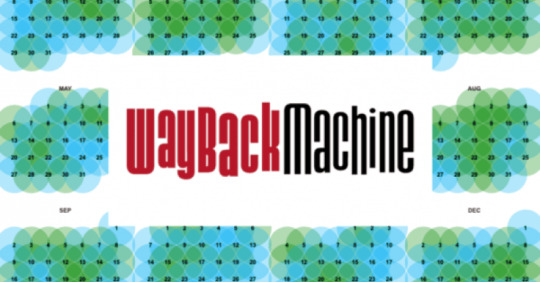
On July 14, I'm giving the closing keynote for the fifteenth HACKERS ON PLANET EARTH, in QUEENS, NY. Happy Bastille Day! On July 20, I'm appearing in CHICAGO at Exile in Bookville.

#20yrsago FastCompany’s terrible linking policy https://memex.craphound.com/2004/06/25/fastcompanys-terrible-linking-policy/
#15yrsago Magic Mirror of the Mermaid Queen, sequel to CHANGELING, a modern folktale of New York https://memex.craphound.com/2009/06/25/magic-mirror-of-the-mermaid-queen-sequel-to-changeling-a-modern-folktale-of-new-york/
#15yrsago Illegal e-waste dumped in Ghana includes unencrypted hard drives full of US security secrets https://web.archive.org/web/20090628071458/https://www.itworld.com/security/69758/reporters-find-northrop-grumman-data-ghana-market
#10yrsago Once there was a show called “The Hat Squad” and it was very, very stupid https://memex.craphound.com/2014/06/25/once-there-was-a-show-called-the-hat-squad-and-it-was-very-very-stupid/
#10yrsago UK secretary of state: “There is no surveillance state” https://www.bbc.com/news/uk-politics-28006739
#10yrsago Cops bust cybercrook who sent heroin to Brian Krebs https://krebsonsecurity.com/2014/06/the-fly-has-been-swatted/
#10yrsago SF city attorney demands shutdown of parking-space-auctioning app https://web.archive.org/web/20140625033523/http://blog.sfgate.com/cityinsider/2014/06/23/sf-cracks-down-on-street-parking-cash-apps/
#5yrsago An 14-year-old’s Internet-of-Things worm is bricking shitty devices by the thousands https://www.zdnet.com/article/new-silex-malware-is-bricking-iot-devices-has-scary-plans/
#5yrsago How Metabrainz stood up to a predatory copyright lawsuit and won https://blog.metabrainz.org/2019/06/25/we-were-sued-by-a-copyright-troll-and-we-prevailed/
#5yrsago “Massive scale” intrusion into mobile carriers’ networks exposed customers’ location, call data for years https://www.cybereason.com/blog/research/operation-soft-cell-a-worldwide-campaign-against-telecommunications-providers
#5yrsago Independent evaluation of “aggression detection” microphones used in schools and hospitals finds them to be worse than useless https://features.propublica.org/aggression-detector/the-unproven-invasive-surveillance-technology-schools-are-using-to-monitor-students/
#5yrsago Microsoft employees want to starve its PAC, which keeps giving money to homophobic, racist, climate-denying Republicans https://onezero.medium.com/a-group-of-microsoft-employees-is-fighting-the-companys-political-action-committee-7dae732290e3
#5yrsago Cult of the Dead Cow: the untold story of the hacktivist group that presaged everything great and terrible about the internet https://memex.craphound.com/2019/06/25/cult-of-the-dead-cow-the-untold-story-of-the-hacktivist-group-that-presaged-everything-great-and-terrible-about-the-internet/

Support me this summer on the Clarion Write-A-Thon and help raise money for the Clarion Science Fiction and Fantasy Writers' Workshop!
4 notes
·
View notes
Text
Bandai Chose Amazon Web Services for Tamagotchi Uni for Two Reasons
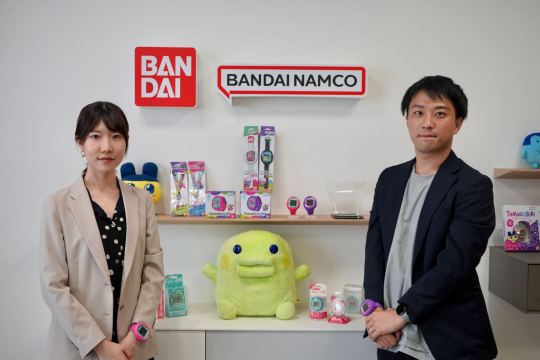
By now we all know that Bandai partnered with Amazon Web Services (AWS) when creating the Tamagotchi Uni. This fuels many features from over the air software updates, and more. In a recent interview with Yuri Okamoto (left) and Daisuke Sakamoto (right), they explain why Tamagotchi Uni uses AWS, and not other platforms such as Azure or Oracle.
According to Mr. Sakamoto, there are two main reasons for adopting AWS as a cloud platform that realizes a series of functions. The first is that AWS provided FreeRTOS, which was decided to be adopted as the OS of the Tamagotchi Uni. FreeRTOS is a real-time operating system kernel for embedded devices. This provides ease of cooperation with the cloud, especially AWS.
The goal for Tamagotchi Uni was to be able to get Tamagotchi users excited all over the world, which was critical during the planning stage.

Second, AWS provided the security Bandai was looking for. This included device authentication. "When it comes to releasing it all over the world and distributing content on the same model, technically, in addition to device authentication, security that children are not exposed to malicious intent is important. Based on that, we compared and examined the IoT services of each company, and as a result, we contacted the AWS inquiry window," said Sakamoto.

"Tamagotchi has released a different series in Japan and overseas, and recently the ones for Europe and the United States have become popular. I think that the global visibility has also increased, and I wanted to provide content where Tamagotchi users from all over the world can get excited together here." (Mr. Okamoto).

Using AWS Bandai is also able to collect data on how children play with Tamagotchi. They do not collect personal information but they are able to measure which items are polar, and Bandai will make sure of that information in the future for content production.

"As a feature of products equipped with Wi-Fi and connected to the cloud, we can now see information such as how much it is played. I want to connect such information to the improvement of future play." (Mr. Sakamoto)
Check out the full article here.
#tamapalace#tamagotchi#tmgc#tamagotchiuni#tamagotchi uni#uni#tamatag#virtualpet#bandai#aws#amazon#monoist#yuriokamoto#yuri okamoto#daisukesakamoto#daisuke sakamoto
20 notes
·
View notes
Text
Dubai's Smart City strategy
Dubai's Smart City Strategy is an ambitious initiative aimed at transforming the city into a global leader in technology, innovation, and sustainability. Launched by the Dubai government, this comprehensive strategy leverages digital technologies and data-driven insights to improve the lives of residents, enhance government services, and foster economic growth.
Key Pillars of Dubai's Smart City Strategy
Digital Transformation: At the core of the strategy is the digitization of government services. This includes providing online access to public services, streamlining administrative processes, and implementing paperless transactions. The goal is to create a seamless and efficient experience for residents and businesses when interacting with the government.
Data-Driven Decision Making: Dubai's Smart City strategy emphasizes the collection and analysis of data to inform decision-making and improve city management. This includes using sensors and IoT devices to gather data on traffic flow, energy consumption, and environmental conditions. By analyzing this data, the city can optimize resource allocation, improve infrastructure planning, and enhance public safety.
Technological Innovation: Dubai is actively promoting the development and adoption of cutting-edge technologies, such as artificial intelligence, blockchain, and cloud computing. This includes supporting research and development initiatives, fostering partnerships with technology companies, and creating a regulatory environment that encourages innovation.
Sustainability: A key focus of the strategy is to create a sustainable and environmentally friendly city. This includes initiatives to promote energy efficiency, reduce carbon emissions, and encourage the use of renewable energy sources. Dubai is also investing in green infrastructure, such as parks and green spaces, to improve the quality of life for residents.
Citizen Engagement: The Smart City strategy emphasizes the importance of citizen engagement and participation. This includes creating platforms for residents to provide feedback, share ideas, and contribute to the development of the city. The goal is to create a sense of community ownership and ensure that the Smart City initiatives align with the needs and aspirations of the people.
Key Initiatives and Achievements
Happiness Meter: Dubai has implemented a "Happiness Meter" to gauge citizen satisfaction with public services and city initiatives. This real-time feedback system helps the government identify areas for improvement and prioritize projects that enhance the well-being of residents.
Paperless Strategy: Dubai has launched a "Paperless Strategy" aimed at eliminating paper transactions in government offices. This initiative has significantly reduced paper consumption, streamlined administrative processes, and improved efficiency.
Smart Mobility: Dubai is investing in smart mobility solutions, such as autonomous vehicles, smart traffic management systems, and integrated public transportation networks. These initiatives aim to reduce traffic congestion, improve road safety, and enhance the overall transportation experience.
Blockchain Strategy: Dubai is exploring the use of blockchain technology to enhance security, transparency, and efficiency in various sectors, including government services, logistics, and healthcare.
AI Lab: Dubai has established an AI Lab to develop and deploy artificial intelligence solutions for city management. This includes initiatives such as using AI to optimize traffic flow, improve public safety, and enhance the efficiency of government services.
Impact and Future Outlook
Dubai's Smart City strategy has already made significant progress in transforming the city into a technologically advanced and sustainable urban center. The initiatives have improved the efficiency of government services, enhanced the quality of life for residents, and attracted investment and innovation.
In the future, Dubai aims to further leverage technology to create a city that is not only smart but also resilient, inclusive, and human-centered. The focus will be on using technology to address challenges such as climate change, social inequality, and economic diversification. By continuing to invest in innovation and prioritize the needs of its citizens, Dubai is poised to become a global model for smart city development.
#Dubai's Smart City strategy#Dubai's Smart City#dubai#dubailife#dubairealestate#abu dhabi#services#uaebusiness#startup#business#dubaivape#jobs in dubai
2 notes
·
View notes
Text
Smart City Parking Solutions in UAE | Innovative & Efficient Systems - Omnitec UAE
Introduction to Smart City Parking Solutions
In today’s rapidly growing urban environments, efficient parking solutions are essential to manage traffic flow and improve city life. Smart city parking solutions, like those offered by Omnitec UAE, integrate advanced technology to enhance the parking experience in metropolitan areas. These solutions not only help reduce congestion but also improve sustainability and the overall efficiency of city infrastructure.
What are Smart City Parking Solutions?
Smart city parking solutions utilize a combination of Internet of Things (IoT) devices, real-time data analytics, and automated systems to optimize parking management. These systems are designed to make the process more convenient for drivers while providing city administrators with valuable insights into parking space usage, traffic patterns, and more.
Key Features of Smart Parking Solutions:
Automated payment systems: Drivers can pay for parking without physical transactions through mobile apps or online portals.
Real-time space availability: Sensors detect available parking spaces and provide live updates to drivers, reducing the time spent searching for parking.
Traffic management: By managing parking demand, cities can reduce traffic congestion, improve air quality, and enhance mobility.
Benefits of Smart City Parking Solutions by Omnitec UAE
Omnitec UAE is at the forefront of providing cutting-edge smart parking systems in the UAE. By leveraging advanced technologies, Omnitec delivers solutions that not only optimize parking but also address broader urban challenges. Here are some of the benefits that come with adopting smart city parking solutions:
Reduced Congestion With real-time data on parking availability, drivers no longer need to circle around to find an open spot. This leads to smoother traffic flow and significantly reduces congestion in busy city areas.
Environmental Impact Efficient parking management cuts down the carbon emissions caused by vehicles idling while looking for parking. This contributes to the overall sustainability goals of a smart city.
Enhanced User Experience Through the use of mobile apps and automated kiosks, drivers enjoy a seamless and stress-free parking experience. They can book parking spots in advance, make contactless payments, and receive real-time updates about parking availability.
Cost-Effective for Cities Smart parking solutions are scalable and adaptable, making them a cost-effective option for cities. These systems allow municipalities to monitor parking spaces and make data-driven decisions about parking infrastructure and city planning.
Security and Monitoring Advanced technologies such as ANPR (Automatic Number Plate Recognition) systems and CCTV surveillance integrated with smart parking solutions ensure the security of parking areas, reducing theft and vandalism.
How Omnitec UAE’s Solutions are Shaping the Future of Urban Parking
Omnitec UAE’s smart city parking solutions are designed to help cities evolve into smarter, more efficient, and greener environments. Their systems not only meet the needs of modern urban mobility but also address the key challenges of overcrowded city spaces, such as:
Dynamic Pricing Models: The system can adjust parking fees based on demand, encouraging drivers to park during off-peak hours, which helps distribute traffic flow more evenly throughout the day.
Data-Driven Insights: With detailed analytics on parking usage, city planners can make informed decisions about infrastructure investments and optimize space allocation.
Why Choose Omnitec UAE for Smart City Parking Solutions?
Omnitec UAE has a proven track record in delivering reliable, scalable, and future-ready parking solutions tailored for smart cities. Their commitment to innovation and technology sets them apart from competitors. Here's why you should consider Omnitec UAE for your city’s parking needs:
Experience and Expertise: With years of expertise in parking management solutions, Omnitec is a trusted partner for many smart cities.
Tailored Solutions: Whether you’re a city administrator, a business owner, or a real estate developer, Omnitec’s parking solutions can be customized to fit your specific needs.
Sustainability Focus: Omnitec’s parking systems are designed with sustainability in mind, helping cities reduce their carbon footprint and promote eco-friendly transportation options.
Conclusion
As cities continue to grow, the demand for efficient, innovative, and scalable parking solutions becomes more pressing. Omnitec UAE’s smart city parking solutions offer a comprehensive approach to urban parking, blending technology with convenience to meet the evolving needs of modern cities. Whether you're looking to enhance mobility, improve sustainability, or streamline parking management, Omnitec UAE has the expertise and technology to make it happen.
For more information on our Smart City Parking Solutions, visit our website. Explore our innovative solutions that are revolutionizing urban parking in the UAE.
2 notes
·
View notes
Text
Revolutionizing Healthcare: The Role of Cloud Computing in Modern Healthcare Technologies
In today’s digital era, cloud computing is transforming industries, and healthcare is no exception. The integration of cloud computing healthcare technologies is reshaping patient care, medical research, and healthcare management. Let’s explore how cloud computing is revolutionizing healthcare and the benefits it brings.
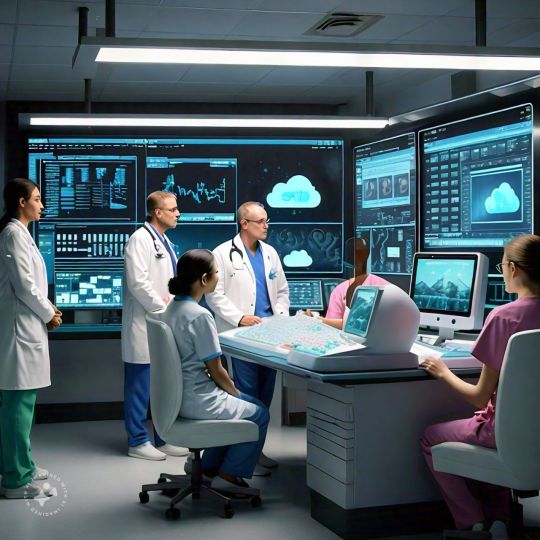
What is Cloud Computing in Healthcare?
Cloud computing in healthcare refers to the use of remote servers to store, manage, and process healthcare data, rather than relying on local servers or personal computers. This technology allows healthcare organizations to access vast amounts of data, collaborate with other institutions, and scale operations seamlessly.
Download PDF Brochure
Key Benefits of Cloud Computing in Healthcare
Enhanced Data Storage and Accessibility Cloud technology allows healthcare providers to store massive volumes of patient data, including medical records, images, and test results, securely. Clinicians can access this data from anywhere, ensuring that patient information is available for timely decision-making.
Improved Collaboration Cloud-based healthcare platforms enable easy sharing of patient data between healthcare providers, specialists, and labs. This facilitates better collaboration and more accurate diagnoses and treatment plans, especially in multi-disciplinary cases.
Cost Efficiency The cloud reduces the need for expensive hardware, software, and in-house IT teams. Healthcare providers only pay for the resources they use, making it a cost-effective solution. Additionally, the scalability of cloud systems ensures they can grow as healthcare organizations expand.
Better Data Security Protecting sensitive patient information is critical in healthcare. Cloud computing providers invest heavily in data security measures such as encryption, multi-factor authentication, and regular audits, ensuring compliance with regulatory standards like HIPAA.
Telemedicine and Remote Patient Monitoring Cloud computing powers telemedicine platforms, allowing patients to consult with doctors virtually, from the comfort of their homes. It also enables remote patient monitoring, where doctors can track patients' health metrics in real time, improving outcomes for chronic conditions.
Advanced Data Analytics The cloud supports the integration of advanced data analytics tools, including artificial intelligence (AI) and machine learning (ML), which can analyze large datasets to predict health trends, track disease outbreaks, and personalize treatment plans based on individual patient data.
Use Cases of Cloud Computing in Healthcare
Electronic Health Records (EHRs): Cloud-based EHRs allow healthcare providers to access and update patient records instantly, improving the quality of care.
Genomics and Precision Medicine: Cloud computing accelerates the processing of large datasets in genomics, supporting research and development in personalized medicine.
Hospital Information Systems (HIS): Cloud-powered HIS streamline hospital operations, from patient admissions to billing, improving efficiency.
Challenges in Cloud Computing for Healthcare
Despite its numerous benefits, there are challenges to implementing cloud computing in healthcare. These include:
Data Privacy Concerns: Although cloud providers offer robust security measures, healthcare organizations must ensure their systems are compliant with local and international regulations.
Integration with Legacy Systems: Many healthcare institutions still rely on outdated technology, making it challenging to integrate cloud solutions smoothly.
Staff Training: Healthcare professionals need adequate training to use cloud-based systems effectively.
Request Sample Pages
The Future of Cloud Computing in Healthcare
The future of healthcare will be increasingly cloud-centric. With advancements in AI, IoT, and big data analytics, cloud computing will continue to drive innovations in personalized medicine, population health management, and patient care. Additionally, with the growing trend of wearable devices and health apps, cloud computing will play a crucial role in integrating and managing data from diverse sources to provide a comprehensive view of patient health.
Conclusion
Cloud computing is not just a trend in healthcare; it is a transformative force driving the industry towards more efficient, secure, and patient-centric care. As healthcare organizations continue to adopt cloud technologies, we can expect to see improved patient outcomes, lower costs, and innovations that were once thought impossible.
Embracing cloud computing in healthcare is essential for any organization aiming to stay at the forefront of medical advancements and patient care.
Content Source:
2 notes
·
View notes
Text

How Seleam Helps Enterprises
Seleam, as a robust fixed assets management system, provides several features and benefits that help enterprises manage their assets effectively:
Centralized Database:
Unified Platform: Maintain all asset information in a single, centralized database accessible to authorized personnel.
Data Integration: Integrate with other enterprise systems (e.g., ERP, accounting software) for seamless data flow.
Advanced Tracking and Monitoring:
Real-Time Tracking: Use barcodes, RFID tags, or IoT sensors for real-time asset tracking.
Condition Monitoring: Continuously monitor the condition of assets to predict failures and plan maintenance.
Automated Processes:
Workflow Automation: Automate routine tasks such as asset check-ins/outs, maintenance scheduling, and depreciation calculations.
Notifications and Alerts: Set up alerts for maintenance due dates, warranty expirations, and compliance deadlines.
Comprehensive Reporting and Analytics:
Customizable Reports: Generate detailed reports on asset utilization, maintenance history, financials, and more.
Data Analytics: Use analytics tools to gain insights into asset performance and make data-driven decisions.
User-Friendly Interface:
Intuitive Dashboard: Provide an easy-to-use dashboard for quick access to key information and metrics.
Mobile Access: Enable remote access through mobile devices for on-the-go asset management.
Scalability and Flexibility:
Scalable Solution: Adapt to the growing needs of the enterprise, whether it's adding more assets or expanding to new locations.
Customization: Offer customizable features to meet the specific requirements of different industries and organizations.
2 notes
·
View notes
Text
CADOpt Technologies: Premium PTC Partner & Top Value-Added Reseller In India

In the fast-evolving landscape of digital design and engineering, having a reliable partner for computer-aided design (CAD) solutions is crucial. CADOpt Technologies has emerged as a beacon of excellence in this domain, establishing itself as a premium PTC partner and one of the top value-added resellers in India. This article delves into the myriad ways CADOpt Technologies stands out, offering insights into their services, solutions, and customer-centric approach.
Comprehensive Solutions Offered by CADOpt Technologies
CAD Software Solutions
One of the core offerings of CADOpt Technologies is their suite of CAD software solutions. These tools are designed to enhance productivity, improve design accuracy, and streamline the engineering process. Some of the key software solutions provided include:
Creo: A robust 3D CAD software that supports product design and development from concept to manufacturing.
Windchill: A product lifecycle management (PLM) solution that facilitates collaboration and data management across the product development lifecycle.
ThingWorx: An industrial Internet of Things (IoT) platform that enables smart, connected operations and products.
Training and Support Services
Understanding that software is only as good as the people using it, CADOpt Technologies places a strong emphasis on training and support. They offer comprehensive training programs tailored to different user levels, ensuring that clients can fully harness the power of their CAD tools. Additionally, their dedicated support team is always on hand to assist with any technical issues, providing timely and effective solutions.
Customization and Integration
Every business has unique needs, and CADOpt Technologies excels in offering customized solutions. They work closely with clients to understand their specific requirements and tailor their CAD tools accordingly. Moreover, their expertise in software integration ensures seamless incorporation of CAD solutions into existing workflows, enhancing overall efficiency.
Why CADOpt Technologies is a Top Value-Added Reseller
Industry Expertise
One of the key factors that set CADOpt Technologies apart is their deep industry expertise. They have a team of seasoned professionals with extensive experience in various sectors, including automotive, aerospace, consumer goods, and industrial equipment. This diverse expertise enables them to provide insights and solutions that are precisely aligned with industry-specific challenges and opportunities.
Customer-Centric Approach
At the heart of CADOpt Technologies' success is their unwavering commitment to customer satisfaction. They adopt a consultative approach, working closely with clients to understand their goals and challenges. This collaborative mindset ensures that the solutions provided are not only effective but also add significant value to the client's business.
Strong After-Sales Support
After-sales support is a critical aspect of any technology partnership, and CADOpt Technologies excels in this regard. Their dedicated support team provides ongoing assistance, ensuring that clients can maximize the benefits of their CAD solutions. From troubleshooting technical issues to providing regular updates and maintenance, CADOpt Technologies is committed to long-term client success.
The Future of CADOpt Technologies
Innovation and Growth
Looking ahead, CADOpt Technologies is poised for continued growth and innovation. They are constantly exploring new technologies and trends to stay ahead of the curve. Their ongoing investment in research and development ensures that they can offer cutting-edge solutions that meet the evolving needs of their clients.
Expansion Plans
CADOpt Technologies has ambitious plans for expansion, both geographically and in terms of service offerings. They aim to extend their footprint across India and beyond, bringing their world-class CAD solutions to a broader audience. Additionally, they are exploring new verticals and industries, leveraging their expertise to drive digital transformation in various sectors.
Conclusion
CADOpt Technologies stands out as a premium PTC partner and top value-added reseller in India, thanks to their innovative solutions, exceptional customer service, and deep industry expertise. Their comprehensive suite of CAD software, coupled with their commitment to customization, training, and support, makes them a trusted partner for businesses seeking to enhance their design and engineering capabilities. As they continue to grow and innovate, CADOpt Technologies is set to play a pivotal role in shaping the future of the CAD industry in India and beyond. For more information on CADOpt Technologies and their offerings, visit their official website or contact their support team for personalized assistance.
#CADOptTechnologies#PTCPartner#CADSolutions#ValueAddedReseller#IndiaTech#CreoSoftware#WindchillPLM#ThingWorxIoT#EngineeringExcellence#DigitalTransformation#TechInnovation#CustomerSupport#CADTraining#IndustryExpertise#ProductDesign#EngineeringSoftware#CADIntegration#TechGrowth#InnovationInCAD#FutureOfDesign#TechResellerIndia
2 notes
·
View notes